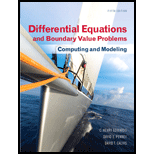
In Problems 17 through 22, an RLC circuit with input voltage E(t) is described. Find the current I(t) using the given initial current (in amperes) and charge on the capacitor (in coulombs).
Want to see the full answer?
Check out a sample textbook solution
Chapter 3 Solutions
MyLab Math with Pearson eText -- 24-Month Standalone Access Card -- For Differential Equations and Boundary Value Problems: Computing and Modeling Tech Update
Additional Engineering Textbook Solutions
Modern Database Management
Starting Out with Java: From Control Structures through Objects (7th Edition) (What's New in Computer Science)
Mechanics of Materials (10th Edition)
Java How to Program, Early Objects (11th Edition) (Deitel: How to Program)
Starting Out with Programming Logic and Design (5th Edition) (What's New in Computer Science)
Degarmo's Materials And Processes In Manufacturing
- I need to make a parallel version of this sequential code.arrow_forwardBenefits of using arrays as instance variables: What are the advantages of incorporating arrays as instance variables within a class? Initializing and managing arrays: How do you initialize and manage arrays within class constructors and mutators (setters)? Example of using arrays as instance variables: Share an example where you have used arrays as instance variables and discuss its application in a real-world scenario. Common mistakes with arrays as instance variables: What are some common mistakes to avoid when working with arrays as instance variables? Information hiding violations: What is the potential violation of information hiding when using arrays as instance variables? How can this be resolved?arrow_forwardDo you think that computers should replace teachers? Give three references with your answer.arrow_forward
- Is online learning or face to face learning better to teach students around the around the world? Give reasons for your answer and provide two references with your response. What are benefits of both online learning and face to face learning ? Give two references with your answer. How does online learning and face to face learning affects students around the world? Give two references with your answer.arrow_forwardExplain Five reasons if computers should replace teachers. Provide three references with your answer. List three advantages and three disadvantages face to face learning and online learning may have on children. Provide two references with your answer.arrow_forwardYou were requested to design IP addresses for the following network using the address block 10.10.10.0/24. Specify an address and net mask for each network and router interfacearrow_forward
- For the following network, propose routing tables in each of the routers R1 to R5arrow_forwardFor the following network, propose routing tables in each of the routers R1 to R5arrow_forwardUsing R language. Here is the information link. http://www.cnachtsheim-text.csom.umn.edu/Kutner/Chapter%20%206%20Data%20Sets/CH06PR18.txtarrow_forward
- Using R languagearrow_forwardHow can I type the Java OOP code by using JOptionPane with this following code below: public static void sellCruiseTicket(Cruise[] allCruises) { //Type the code here }arrow_forwardDraw a system/level-0 diagram for this scenario: You are developing a new customer relationship management system for the BEC store, which rents out movies to customers. Customers will provide comments on new products, and request rental extensions and new products, each of which will be stored into the system and used by the manager for purchasing movies, extra copies, etc. Each month, one employee of BEC will select their favorite movie pick of that week, which will be stored in the system. The actual inventory information will be stored in the Entertainment Tracker system, and would be retrieved by this new system as and when necessary. Example of what a level-0 diagram looks like is attached.arrow_forward
 C++ for Engineers and ScientistsComputer ScienceISBN:9781133187844Author:Bronson, Gary J.Publisher:Course Technology Ptr
C++ for Engineers and ScientistsComputer ScienceISBN:9781133187844Author:Bronson, Gary J.Publisher:Course Technology Ptr Operations Research : Applications and AlgorithmsComputer ScienceISBN:9780534380588Author:Wayne L. WinstonPublisher:Brooks Cole
Operations Research : Applications and AlgorithmsComputer ScienceISBN:9780534380588Author:Wayne L. WinstonPublisher:Brooks Cole Systems ArchitectureComputer ScienceISBN:9781305080195Author:Stephen D. BurdPublisher:Cengage Learning
Systems ArchitectureComputer ScienceISBN:9781305080195Author:Stephen D. BurdPublisher:Cengage Learning Principles of Information Systems (MindTap Course...Computer ScienceISBN:9781285867168Author:Ralph Stair, George ReynoldsPublisher:Cengage Learning
Principles of Information Systems (MindTap Course...Computer ScienceISBN:9781285867168Author:Ralph Stair, George ReynoldsPublisher:Cengage Learning Fundamentals of Information SystemsComputer ScienceISBN:9781337097536Author:Ralph Stair, George ReynoldsPublisher:Cengage LearningProgramming Logic & Design ComprehensiveComputer ScienceISBN:9781337669405Author:FARRELLPublisher:Cengage
Fundamentals of Information SystemsComputer ScienceISBN:9781337097536Author:Ralph Stair, George ReynoldsPublisher:Cengage LearningProgramming Logic & Design ComprehensiveComputer ScienceISBN:9781337669405Author:FARRELLPublisher:Cengage





